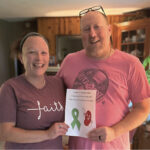 What might seem like a fetid, murky backwater to you is an afternoon of exploration for Keith Williams.
What might seem like a fetid, murky backwater to you is an afternoon of exploration for Keith Williams.
After all, there is life in even the most neglected and forgotten corners of the Susquehanna River’s many tributaries, streams and pools. And, for an explorer like Williams, every such corner is a new chance to discover, to interact and to understand the complex story of the sprawling watershed.
Williams began exploring the creeks and backwaters of the Susquehanna River about a decade ago after seeing a film called “River Webs” about a Japanese field biologist who pioneered the art and science of studying small water ecosystems. Williams figured he could do the same thing.
“I knew that interacting with the waterways was the best way to study them,” he said.
As a trained environmental biologist, he knew what to look for. As a part-time rescue diver, he had the gear and the knowhow. As executive director of NorthBay, an environmental education and outreach center on Elk Neck in Maryland, he had the mission: teaching students about the impact our choices have on the environment.
And getting more people in contact with creeks and rivers is his manifest mission. He makes regular visits to streams and rivers from suburban Philadelphia to the Allegheny Plateau, sometimes with NorthBay students, sometimes alone. Mostly, his expeditions focus on small sections of water, but he’s done 10-mile snorkels before.
Today’s spot is one of Williams’ favorite. It’s a pool hugging the east bank of the Susquehanna below Safe Harbor Dam at what used to be an old canal lock. Barely larger than a backyard swimming pool and scarcely more than 2 feet deep, it doesn’t look like much upon first glance.
There is barely a trickle of water going into it. Jagged, slippery rocks surround it on three sides. Safe to say hardly any feet ever trod there.
But donning his wetsuit and a mask with the relaxed speed of a professional, Williams is soon in the cool water like an eager kid. He has more than once wondered what horrific thoughts people think when they see him face down in a stream.
As expected, life abounds here: log perch, sunfish, dace. An eastern water snake slides effortlessly between the rocks along the edge of the pool.
And there are crayfish. Lots and lots of crayfish—big ones, too. Williams, however, is concerned. These are not natives, but an invasive brand called rusties. They can devastate ecosystems. They eat more, grow faster and are more numerous than most waterways can handle.
Even with the invaders, this spot on this day seems relatively healthy, he said.
“There was a lot happening down there,” he says, stepping out onto the warm rocks. “I come here a lot, and every time there is something different happening.”
Today’s discoveries include a small school of stonerollers, barely an inch in length, dancing through the shallows. Despite their small size, he can spot them from their behavior alone.
Getting to know this little slice of a big river system is what Williams sees as the truest way of doing environmental science. Real science is about following a sense of wonder, and Williams still has it.
“It’s amazing the stuff you learn from observation, and, with the perspective of learning it in a tiny mountain creek,” he said.
And this from a guy who’s snorkeled the Great Barrier Reef off of Australia.
“Of course, this isn’t as colorful, but the things I see here are every bit as complex and interesting,” he said.
Can you describe the color changes of male creek chubs prior to spawning? Williams can.
“Their colors can rival some tropical bird species,” he said.
And it’s a pastime that doesn’t depend on the seasons. With the right gear, Williams can explore streams on the coldest of days. It means he sees things that few other people will ever see, let alone imagine.
“You would be amazed at what is still happening in the winter,” he said. “It’s a lot quieter to be sure, but stuff is still happening under the ice.”
With all of Williams’ experience, every trip has a surprise, a revelation or a sign of hope in what are often highly stressed waters. Progress is indeed measured in tiny increments often reduced to numbers on a spreadsheet. But the re-appearance of a single species of benthic insect can mean big improvements.
“You’re not going to see that unless you spend time looking,” he said.
Given that deforestation, soil runoff, nutrient loading, coal dust, industrial and municipal pollution have had their effect for more than three centuries, some may think it’s a wonder the Susquehanna can support life at all.
“If you can eliminate these problems and give it half a chance, this river can recover,” he said. “Its resilience is remarkable.”
It only takes a few horror stories in the era of social media to make people think there is no hope: a fire at a fertilizer plant that kills an entire ecosytem, a cancerous smallmouth or intersex mutations in fish populations. The Susquehanna is at a crossroads. But Williams, for one, sees possibilities.
“The river is truly impacted, but that doesn’t mean we cannot make contact with it,” he said. “We have to if we want to understand it.”
To learn more about Keith Williams’ work and see some of his stunning photographs of the Susquehanna River watershed, visit www.creeksnorkling.blogspot.com.





